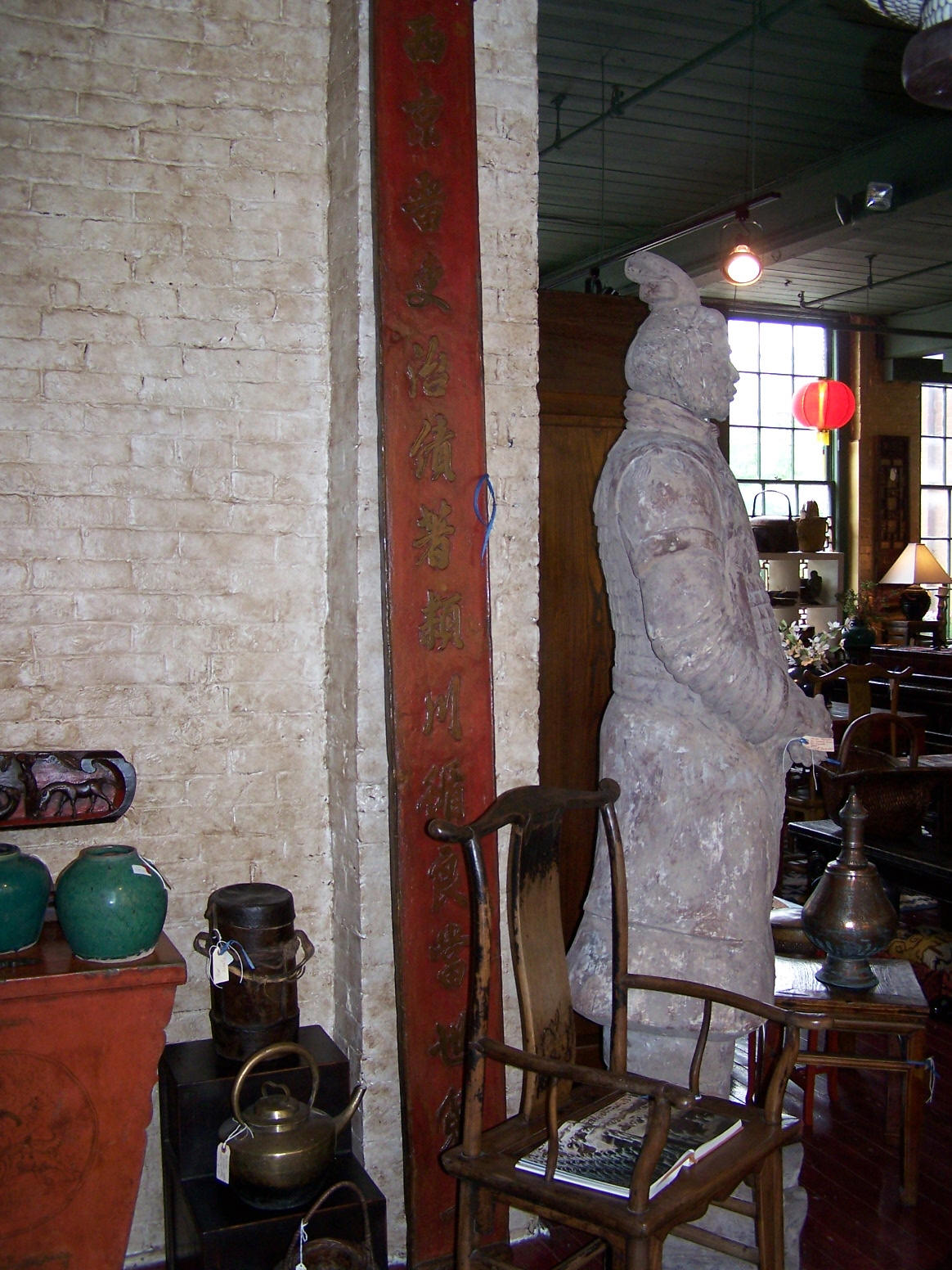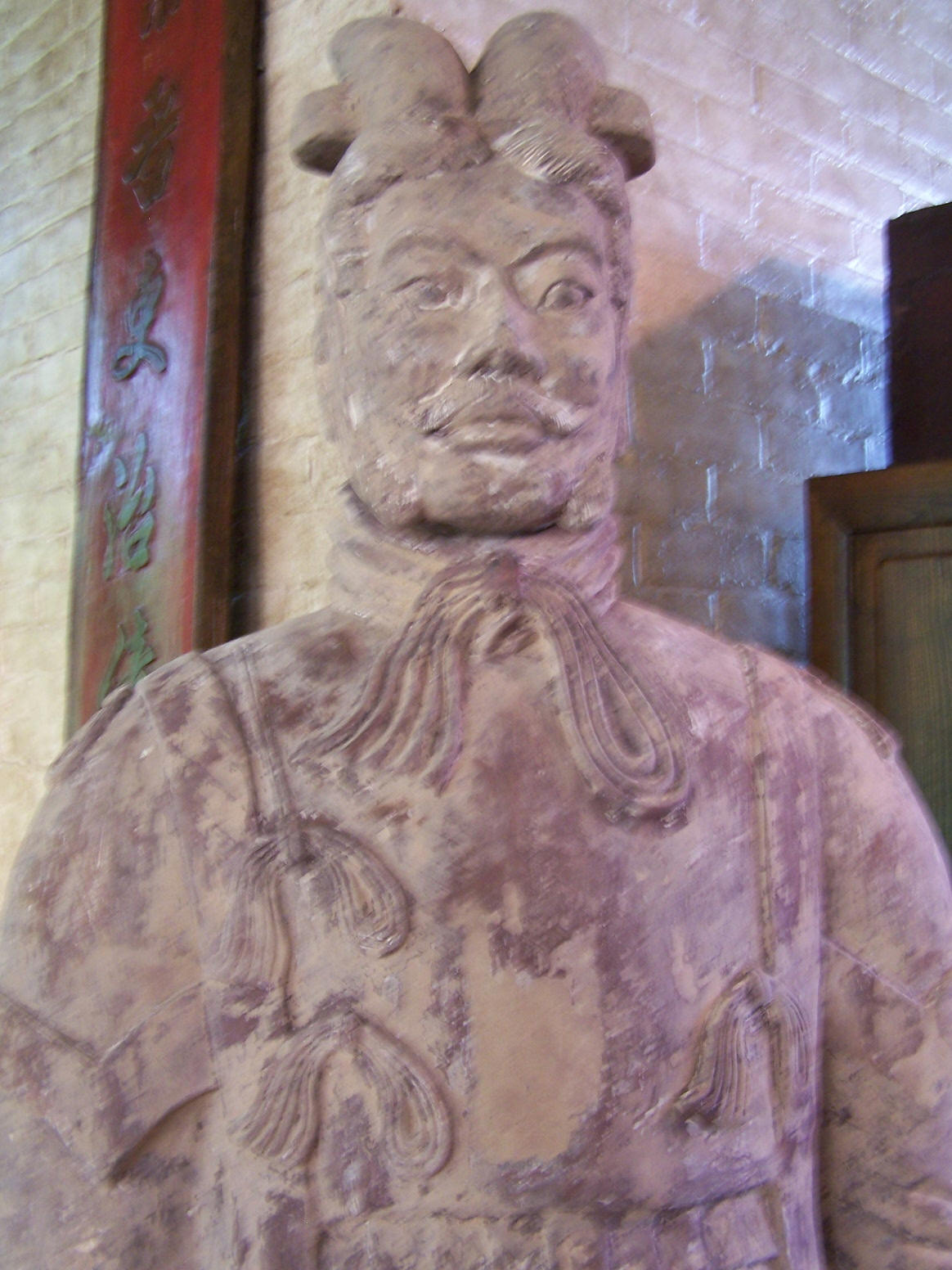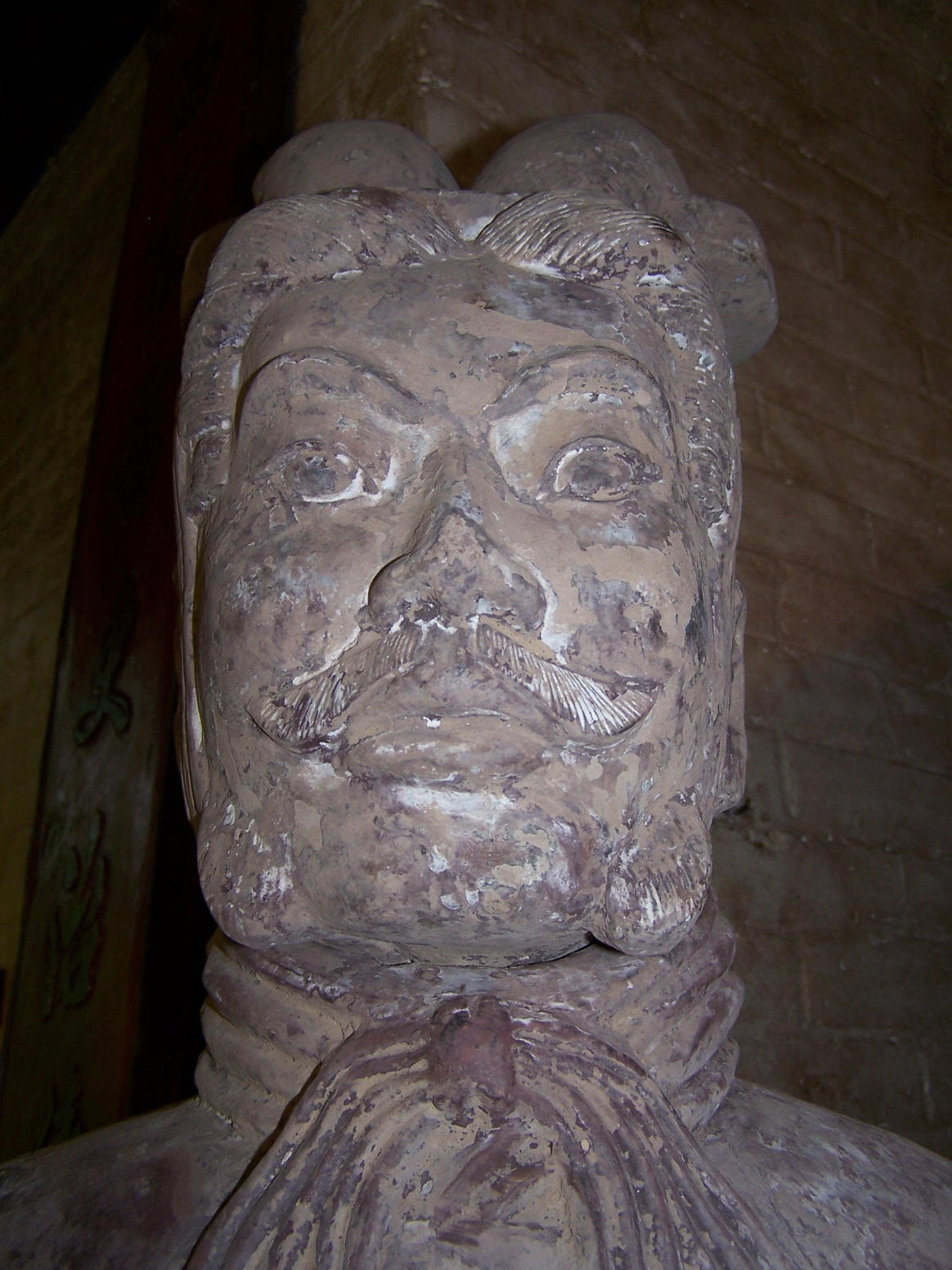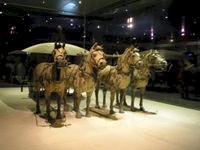
View of the largest excavation pit of the Terracotta Army.

View of the museum of Terracotta Army from outside (2002).
The terracotta figures were buried with the first Emperor
of Qin
(Qin
Shi Huang) in 210-209
BC. Consequently, they are also sometimes referred to as "Qin's
Army".
The Terracotta Army was discovered in March 1974 by local farmers
drilling a water well to the east of Mount Lishan. Mount Lishan is the
name of the man-made necropolis of the First Emperor of the Qin
Dynasty; [Qin Shi Huang]. This is also where the material to make the
terracotta warriors was made, and found. Construction of this
mausoleum began in 246
BC and is believed to have taken 700,000 workers and craftsmen 38
years to complete. Qin Shi Huang was interred inside the tomb complex
upon his death in 210
BC. According to the Grand Historian Sima
Qian, the First Emperor was buried alongside great amounts of
treasure and objects of craftsmanship, as well as a scale replica of
the universe complete with gemmed ceilings representing the cosmos,
and flowing mercury
representing the great earthly bodies of water. Pearls were also
placed on the ceilings in the tomb to represent the stars and planets,
etc. Recent scientific work at the site has shown high levels of
mercury in the soil of Mount Lishan, tentatively indicating an
accurate description of the site's contents by Sima Qian.
The tomb of Qin Shi Huang is near an earthen pyramid 76 meters tall
and nearly 350 meters square. The tomb presently remains unopened and
unfound. There are plans to seal-off the area around the tomb with a
special tent-type structure to prevent corrosion from exposure to
outside air. However, there is at present only one company in the
world that makes these tents, and their largest model will not cover
the site as needed.

A terracotta soldier and his horse
Qin Shi Huang's necropolis complex was constructed to serve as an
imperial compound or palace. It is comprised of several offices, halls
and other structures and is surrounded by a wall with gateway
entrances. The remains of the craftsmen working in the tomb may also
be found within its confines, as it is believed they were sealed
inside alive to keep them from divulging any secrets about its riches
or entrance. It was only fitting, therefore, to have this compound
protected by the massive terra cotta army interred nearby.
Archaeology of the Terracotta Army
Archaeological excavations of the Terracotta Army are still ongoing
over thirty years after its discovery. This is largely due to the
fragile nature of the material and its difficult preservation.
Terracotta is literally “baked earth” which is kiln fired at
relatively low temperatures. After firing each figure in the
Terracotta Army was coated with a lacquer finish to improve
durability. Various colors were also applied in order to create a more
realistic appearance of the figures and their clothing and equipment.
Some excavated materials still retain traces of this coloring; however
their exposure to air quickly causes the finish to chip or flake off.

A group of terracotta soldiers
8000 figures have thus far been unearthed at the site. These
figures include infantry, archers, and officers and are manufactured
in a crouching or standing pose. Each figure was given a real weapon
such as bronze spears, halberds or swords, or wooden crossbows with
bronze fittings. It is believed these weapons date to as early as 228
BC and may have been used in actual warfare. Along with the
soldiers and officers, chariots made with great detail and precision
were also included as part of Qin Shi Huang's army.
The terracotta figures were found in three separate pits, with an
empty fourth pit also discovered. It is believed that the largest pit,
holding over 6,000 figures of infantrymen, chariots and horses, was
representative of the First Emperor's main army. This feature faces
east and covers an area of 172,000 square feet. The second pit
contains about 1,400 figures of cavalry and infantry along with
chariots. This segment is thought to represent a military guard since
it is much smaller than the first, measuring 64,500 square feet. The
third pit contains the command unit, comprised of high ranking
officers, lesser officers, and a war chariot drawn by four horses. It
is the smallest of the four and contains 68 figures within a 5,000
square foot area.
Construction
The terracotta figures were manufactured both in workshops by
government laborers and also by local craftsmen. It is believed they
were made in much the same way that terracotta drainage pipes were
manufactured at the time. This would make it a factory line style of
production, with specific parts manufactured and assembled after being
fired as opposed to crafting one solid piece of terracotta and
subsequently firing it. After completion, the terracotta figures were
placed in the pits outlined above in precise military formation
according to rank and duty.
The terracotta figures are life-like and life-sized. They vary in
height, uniform and hairstyle in accordance with rank. The colored
lacquer finish, molded faces (each is individual), and real weapons
and armor used in manufacturing these figures creates a realistic
appearance and stands as a testament to the amount of labor and skill
involved in their construction. It is also proof of the incredible
amount of power the First Emperor possessed to order such a monumental
undertaking as the manufacturing of the Terracotta Army.
Destruction
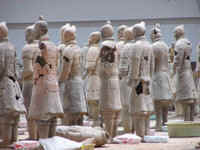
Terracotta figures in various stages of re-assembly after being
unearthed.
Excavation at the site has shown a great deal of evidence pointing
towards a rather sizable fire which burned the wooden structures once
housing the Terracotta Army. Such a fire is described by Sima Qian as
part of the consequences of the raiding General Xiang
Yu less than five years after the death of the First Emperor. It
is said that the effects of General Xiang's army included looting of
the tomb and structures holding the Terracotta Army, as well as
setting fire to the necropolis and starting a blaze that lasted for
three months. Despite this fire, however, much of the remains of the
Terracotta Army still survive in various stages of preservation,
surrounded by remnants of the burnt wooden structures.
Today nearly two million people visit the site annually, and almost
one-fifth are foreigners. The Terracotta Army now serves as both a
phenomenal archaeological discovery as well as an icon of China's
distant past recognizable the world over. The power and military
achievement of the First Emperor Qin Shi Huang is evident in the
massive and monumental achievements present throughout his tomb
complex, most notably the 8,000+ terracotta figures eternally serving
to protect their leader.







